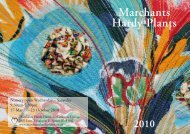download our catalogue free in pdf format here - Marchants Hardy ...
download our catalogue free in pdf format here - Marchants Hardy ...
download our catalogue free in pdf format here - Marchants Hardy ...
You also want an ePaper? Increase the reach of your titles
YUMPU automatically turns print PDFs into web optimized ePapers that Google loves.
28<br />
29<br />
*SCHIZOSTYLIS cocc<strong>in</strong>ea ‘Good White’. Or as near as with the fa<strong>in</strong>test touch of<br />
p<strong>in</strong>k <strong>in</strong> the flower upon open<strong>in</strong>g.<br />
S. c. ‘Marchant’s Seedl<strong>in</strong>g’. The p<strong>in</strong>k you might f<strong>in</strong>d someone dangerously pa<strong>in</strong>t<strong>in</strong>g<br />
their Suffolk cottage <strong>in</strong>. Our own selection.<br />
SEDUM<br />
Sedums have been a ma<strong>in</strong>stay for us <strong>here</strong> at <strong>Marchants</strong> ever s<strong>in</strong>ce <strong>our</strong> arrival <strong>in</strong> 1998<br />
when Sedum ‘Purple Emperor’ travelled with me from my previous work place. This<br />
f<strong>in</strong>e plant arose <strong>in</strong> my parent’s garden at a time when t<strong>here</strong> were few Sedums to draw<br />
upon and has s<strong>in</strong>ce received great accolades. This led me to select several other forms,<br />
three of which received the RHS’s highest award (AGM) <strong>in</strong> their Sedum trial at Wisley.<br />
S<strong>in</strong>ce then others have taken up the gauntlet and we have witnessed the arrival of many<br />
good new plants.<br />
Sedums are plants of <strong>free</strong> dra<strong>in</strong><strong>in</strong>g soils and have not always been easy for us on <strong>our</strong><br />
w<strong>in</strong>ter wet clay. What’s more, with ensu<strong>in</strong>g global warn<strong>in</strong>g a significant pest of Sedums<br />
is becom<strong>in</strong>g <strong>in</strong>creas<strong>in</strong>gly common particularly <strong>in</strong> the hotter South East <strong>in</strong> the form<br />
of catterpillars of a small native moth. These are never happier than when munch<strong>in</strong>g<br />
through a host plant, reduc<strong>in</strong>g it to a skeletal form. Our advice is to keep an eye open<br />
and act quickly if y<strong>our</strong> own Sedums become affected. Sprays seem not to be effective<br />
so it is best to remove caterpillars manually which <strong>in</strong> itself is not an easy task.<br />
In conclusion, Sedums for the foreseeable future will not be appear<strong>in</strong>g on the nursery<br />
so frequently as they have <strong>in</strong> the past. Rest assured, we are work<strong>in</strong>g to resolve these<br />
problems and look forward to the day when these <strong>in</strong>dispensable plants hopefully feature<br />
once aga<strong>in</strong> <strong>in</strong> <strong>our</strong> <strong>catalogue</strong>.<br />
SELINUM tenuifolium. From the Himalayas, this ref<strong>in</strong>ed Umbellifer is like a vastly<br />
superior ‘Queen Anne’s Lace’. The fresh green lacy foliage is crowned <strong>in</strong> June with flat<br />
umbels of white flowers supported on stout, ribbed stems. 120cm.<br />
SEMPERVIVUM. We’ve enjoyed gather<strong>in</strong>g a small collection of Houseleeks over<br />
the years, and of c<strong>our</strong>se lovely pots <strong>in</strong> which to grow them. Kids seem to love them as<br />
much as we do. We hope to have the follow<strong>in</strong>g for sale.<br />
S. ciliosum x grandiflorum, S. ‘Irazu’, S. marmoreum brunneifolium, S. nevadense<br />
hirtellum, S.‘Spiders Lair’, S. ‘Stuffed Olive’, S. tectorum glaucum, etc.<br />
*SERRATULA seaonei. A modest, little known plant which makes its unassum<strong>in</strong>g<br />
entry late <strong>in</strong> the season with fuzzy pale violet aster like flowers over deeply cut foliage.<br />
Charm<strong>in</strong>g. 30cm.<br />
SISYRINCHIUM. Relatives of Iris, the smaller varieties that follow all have large<br />
flowers and are excellent for use on the rockery, raised beds or border front alike.<br />
Whilst they may need divid<strong>in</strong>g occasionally to keep them <strong>in</strong> good spirits, they have<br />
settled down well <strong>here</strong> on <strong>our</strong> heavy clay soil. Do give them lots of sun.<br />
S. idahoense bellum ‘Pale Form’. Large flowers, a most beautiful shade of grey-blue.<br />
20cm.<br />
S. ‘<strong>Marchants</strong> Seedl<strong>in</strong>g’. A very short dark violet seedl<strong>in</strong>g spotted on one of <strong>our</strong> raised<br />
beds. Has performed well. 5cm<br />
S. striatum ‘Aunt May’. This strik<strong>in</strong>g variegated form arose <strong>in</strong> Devon and needs little<br />
<strong>in</strong>troduction. Cream flowers. 35cm<br />
£4.75<br />
£4.75<br />
£5.00<br />
From<br />
£3.25<br />
£4.80<br />
From<br />
£4.65<br />
*SOLIDAGO caesia. The golden-yellow flowers of this attractive Golden Rod are<br />
carried on dark, branched stems. At 45cm a valuable plant for a late display at the<br />
border front.<br />
S. rugosa ‘Firecracker’. A great descriptive name, the slender spikes of golden yellow<br />
flowers make a bright display among <strong>our</strong> tall grasses <strong>in</strong> the autumn. 1.2m.<br />
STACHYS macrantha superba. Whorls of good sized rose-purple flowers over<br />
handsome, leafy clumps. A first class, bomb proof plant suitable for lazy gardeners.<br />
50cm.<br />
S. monieri ‘Hummelo’. An Ernst Pagels selection produc<strong>in</strong>g neat spikes of lilac-purple<br />
flowers <strong>in</strong> mid-summer. 60cm.<br />
S. offic<strong>in</strong>alis ‘Alba’ Short spikes of pure white flowers <strong>in</strong> summer over mounds of pert,<br />
evergreen leaves. A lovely plant, utterly dependable. 30cm.<br />
S. off. ‘Marchant’s P<strong>in</strong>k’. This good deep p<strong>in</strong>k seedl<strong>in</strong>g cropped up <strong>in</strong> a batch of<br />
seedl<strong>in</strong>gs of the above and belongs to the border front battalion.<br />
S. off. ‘Rosea’. An easy to please rose-p<strong>in</strong>k form, which has never grown taller than<br />
30cm with us and also sits very happily at the border’s edge.<br />
STOKESIA laevis ‘Mary Gregory’. Large Cornflower like flowers <strong>in</strong> pale yellow over<br />
strap shaped leaves make for an <strong>in</strong>terest<strong>in</strong>g col<strong>our</strong> break <strong>in</strong> this genus. 40cm.<br />
*STROBILANTHES rankaiensis. Shorter, later and with less hairy leaves than the<br />
follow<strong>in</strong>g this rema<strong>in</strong>s an excellent autumn flower<strong>in</strong>g perennial. 90cm.<br />
*S. wallichii. A handsome late flower<strong>in</strong>g perennial provid<strong>in</strong>g a show of sizeable hooded<br />
pale violet-blue flowers over a copious mound of bristly, large leaves. 120cm.<br />
TANACETUM corymbosum ‘Festtafal’. A highly effective Marguerite, with<br />
Pyrethrum like silver–green leaves and flat corymbs of small white flowers <strong>in</strong> summer.<br />
90cm.<br />
*THALICTRUM aquilegifolium ‘Small Thundercloud’. A corker of a plant, T.<br />
aquilegifolium <strong>in</strong> m<strong>in</strong>iature. Creates considerably more than a storm <strong>in</strong> a tea cup with<br />
its generous clouds of purple flowers. 40cm.<br />
T. delavayi. W. Ch<strong>in</strong>a. The small, nodd<strong>in</strong>g rosy lilac flowers with their prom<strong>in</strong>ent<br />
stamens provide an entranc<strong>in</strong>g display on their tracery of wiry stems <strong>in</strong> summer. A<br />
ref<strong>in</strong>ed plant <strong>in</strong> every respect. 1.5m.<br />
*T. delavayi ‘Album’. An exquisite beauty with small cupped, virg<strong>in</strong> white flowers<br />
held en masse on wiry stems <strong>in</strong> summer. A plant for y<strong>our</strong> very best soil.<br />
T. ‘El<strong>in</strong>’. Vigorous and impos<strong>in</strong>g hybrid (T. flavum glaucum x T.rochebruneanum) 2.5<br />
metres+.<br />
THYMUS. Indispensable for the kitchen and flower border alike.<br />
*T. pseudolanug<strong>in</strong>osus. With a name like this, small wonder it cowers so close to the<br />
ground. As soft as Molesk<strong>in</strong> to the touch. 5cm.<br />
T. ‘P<strong>in</strong>ewood’. A low spread<strong>in</strong>g thyme with a res<strong>in</strong>ous p<strong>in</strong>ewood aroma. 15cm.<br />
*T. vulgaris. A highly aromatic clone which we’ve grown for years. Will add its magic<br />
to many a dish.<br />
TRIFOLIUM ochroleucon. Masses of large creamy yellow heads all summer over<br />
clumps of trefoil leaves. The flowers age k<strong>in</strong>dly. 45cm.<br />
£4.75<br />
£4.85<br />
£4.75<br />
£4.75<br />
£4.75<br />
£4.75<br />
£4.75<br />
£4.60<br />
£4.85<br />
£4.85<br />
£4.80<br />
£5.30<br />
£5.00<br />
£5.20<br />
From<br />
£5.00<br />
From<br />
£4.25<br />
£4.85





